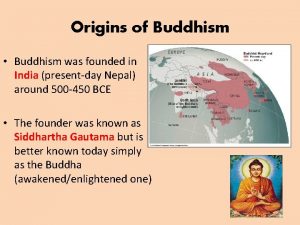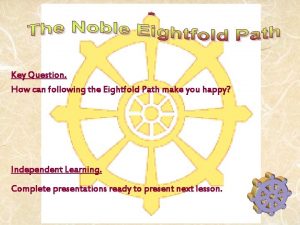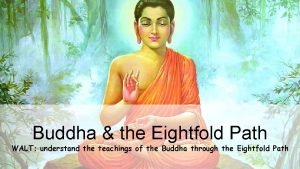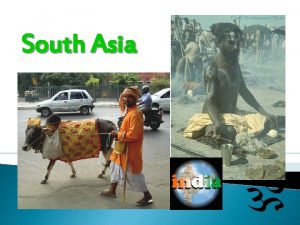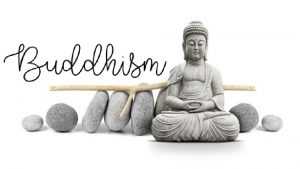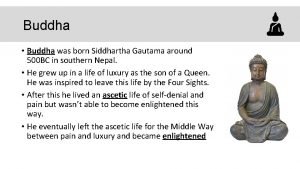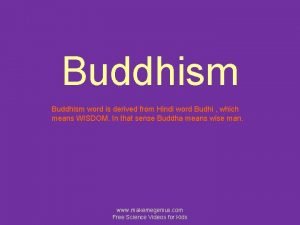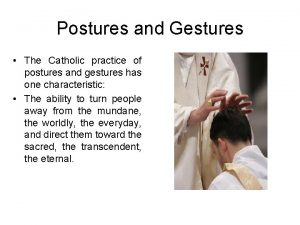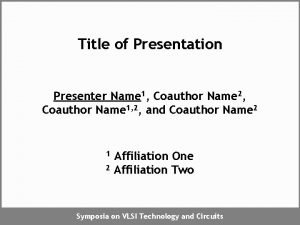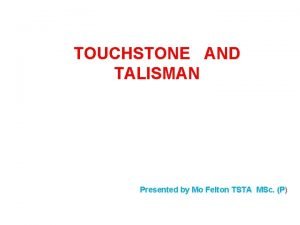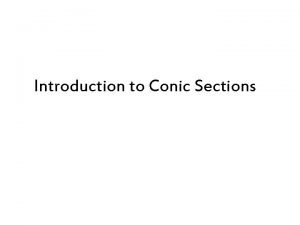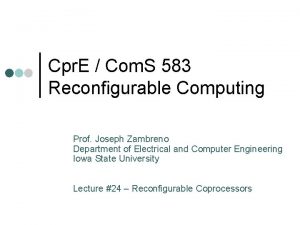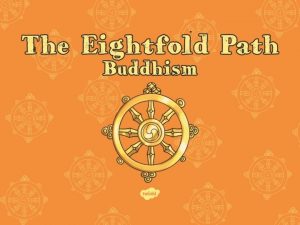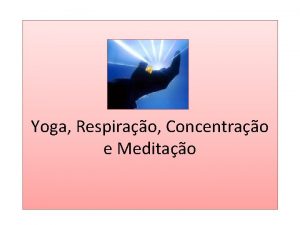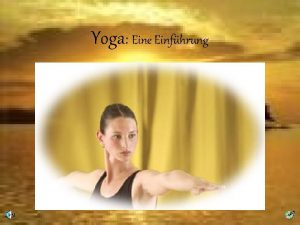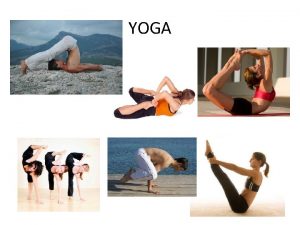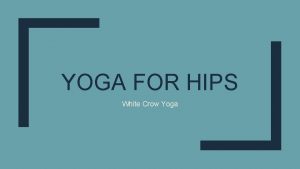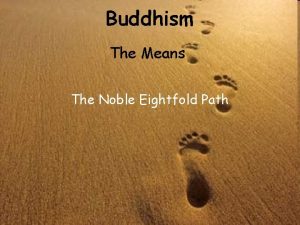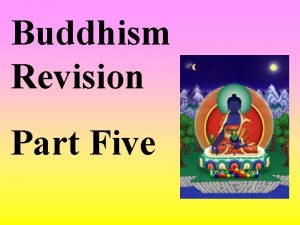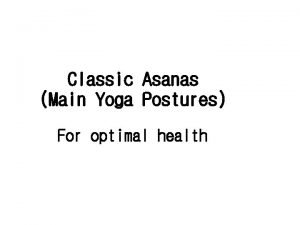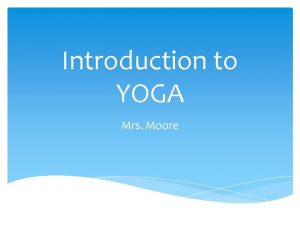Introduction to Yoga Eightfold path Yoga postures Presented











































- Slides: 43

Introduction to Yoga – Eight-fold path & Yoga postures Presented by: Didi Ananda Krpa Revised by: Dharmadeva

What is Yoga? v It comes from root word ‘yunj’ (Sanskrit) - which means to unify, to unite. v It is not like the union of sand sugar; but is like the union of sugar dissolved in water, which, once merged, cannot be separated.

Yoga as Science v Yoga is a system of practices that encourages the harmony and union of body, mind, & spirit - and gives a sense of Oneness. v Yoga is really a spiritual science.

Shiva – the Father of Tantra v v v Shiva lived as a great spiritual master on this planet more than 7, 000 years ago. He systematized all the practices of yoga. He systematized and taught the science of meditation, which is the greatest treasure that anyone can ever give.

Raja Yoga v In the West, yoga has often been associated with body contortions, youth, beauty, and long life. Actually this is only related to one type of yoga – HATHA YOGA. v Broadly, YOGA is an intuitional science. v Raja Yoga is known as Astaunga Yoga, or 8 -fold yoga, a systematic approach to mastery of ourselves.

8 -limbed System of Yoga Yama - external moral / ethical discipline. v Niyama - internal moral / ethical strength. v Asana - yogic postures. v Pranayama - proper breathing for vital energy. v

8 -limbed System of Yoga (con’t) Pratyahara - withdrawal of senses from the external world to internalize your consciousness for meditation. v Dharana - concentration, or extended mental focusing, fundamental to yogic meditation. v Dhyana - process of meditation, the principal practice of bringing your mind to ideate on Oneness. v

8 -limbed System of Yoga (con’t) v Samadhi - experience of unitive consciousness, so as to feel inwardly one with the feeling of Infinite Peace / Cosmic Consciousness.

Tantra v v v What is Tantra? It is the basis of intuitional science. Root words: – Tan - which means ‘expand’; and – Tra - which means ‘liberator’. Origin of all branches of yoga practices. Examples: bhakti yoga jinana yoga karma yoga dhyana yoga kriya yoga hatha yoga raja yoga astaunga yoga mantra yoga

Important Aspects of Yoga v Bhakti Yoga - discipline of love and devotion v Jinana Yoga - discipline of cultivating highest intellectual understanding v Karma Yoga - discipline of selftranscending action and service

Hatha Yoga v v v Places special emphasis on physical postures integrated with harmonized breathing. Allows for control over bodily functions which influence the mind. Hatha yoga is the science of yoga that deals with the practice of asanas (yoga postures).

How Yoga Postures Began v v v Yoga poses were developed thousand of years ago by yogis who observed different animals in the jungles – how they moved, how they rested, how they instinctively cured themselves when sick. The yogis experimented with different animal postures on their own bodies and felt the subtle effects of these movements on their own organs and glands. After centuries of experimentation, these postures were refined into a scientific system of thousands of exercises called ‘asanas’.

What are Asanas? v The root meaning of the word ‘asana’ is a position in which one feels comfortable. v They are yoga postures which when practiced regularly, the body stays healthy, flexible, strong and hardy. v They also help in preventing and curing diseases.

Asanas – Stationery Poses v v v Asanas are practiced as stationary poses in which the body & mind are relaxed and composed. They are accompanied by gentle movements, deep breathing and pointed concentration. They give the same benefits as vigorous exercises, of stimulating circulation and increasing the supply of oxygen to the cells.

Asanas vs Exercises v v v However, with vigorous exercise this extra supply of oxygen is used up during the exercises. Whereas during the practice of asanas, energy is accumulated rather than spent. The main difference between asanas and forms of vigorous exercises is that asanas affect the internal organs and are not just like skeletal or muscular exercises.

The Endocrine Glands v Yoga postures, when properly done, affect mainly the glands and internal organs. v The endocrine glands secrete chemical substances called hormones into the blood stream which affect both body and mind. - For instance, sometimes at ovulation when estrogen and progesterone hormonal levels are high, women are optimistic. - Whereas, sometimes women can be unfriendly when estrogen levels are lowest during the premenstrual time.

Over or Under-secretion of Glands v v Over or under-secretion of the endocrine glands, in people, may cause not only sickness but various mental and emotional disturbances. Can also cause negative emotions such as anxiety, fear, anger & hatred, which destroy our health and mental peace. The yogic asanas exert a subtle pressure on the different glands, restoring a balanced secretion of hormones, and bring about emotional equilibrium and mental peace. They also develop spiritual sentiment.

Importance of Asanas v v v Balance the endocrine glands & control the emotions. Revitalize the nervous system. Improve blood circulation. Relax any tensions in the muscles. Can correct defective postures. Calm the mind.

Overall Benefits of Asanas v v v v Improves muscle tone, flexibility, strength and stamina Easy movement of the body Tones the organs Aids in blood circulation Stimulates immune system Lowers blood pressure and cholesterol Reduces fat v v v v Is cleansing Improves breathing Reduces stress and tension Improves concentration and creativity Creates sense of wellbeing and calmness Boosts self-esteem Elevates the mind Creates spiritual sentiment

Postures and Meridians v v Asanas affect the energy flow of the body. There are 12 major meridians of chi or energy in the body. Most of these are related to a particular internal organ with which it transverses. Yoga asanas directly put pressure on these key points, strengthening the meridians, and if necessary redirecting the circulation of vital energy within them. Yoga postures as ‘self– acupuncture’ stimulate the

Chakras – Psychic Centers v v Chakras are subtle energy centers along the spinal column. These psychic centers are also related to the endocrine glands. They find a psycho-physical manifestation in conjunction with the glands. Asanas affect the chakras.

Chakras – Main List v There are seven conventional chakras: – 1 st chakra = Muladhara - terranean – 2 nd chakra = Svadhisthana - fluidal – 3 rd chakra = Manipura - igneous – 4 th chakra = Anahata - solar – 5 th chakra = Visuddha - sidereal – 6 th chakra = Ajina – 7 th chakra = Sahasrara - lunar - 1000 petals

Concentration Points for Chakras 1) Mu'la'dha'ra - base of the spine, above the perineum; 2) Sva'dhis't'ha'na - base of the genital organ; 3) Man'ipura - navel; 4) Ana'hata - midpoint of the chest; 5) Vishuddha - throat; 6) A'jina‘ - between the eyebrows; 7) Sahasra'ra - crown of the head.

Asana Practice – for Maximum Effect v Must be comfortable to the yogi, as effect on glands and chakras is very important. v Best practiced in the early morning before meals and in the late afternoon or early evening before meals. v Do 2 - 3 hours after eating; On finishing, leave 20 - 30 minutes before eating. v

Things to Remember v Breathing control. v Conscious stretching: - no pain should be felt. v Counter positions or balance: - must treat the body equally by stretching each side of body equally and in opposite directions.

Asanas – the Proper Flow Important aspects: v Moving into the pose v Maintaining the pose v Coming out of the pose

Some basic asanas - Yoga mudra A good warm-up

Some basic asanas - Cobra Counter-balance the first warm-up

Some basic asanas for memory and - Hare Goodintellect

Some basic asanas - Boat Good for navel which is the controlling point of the body

Some basic asanas - Shoulder stand Helps increase longevity, invigorates all the lower chakras, cures many diseases. High blood pressure patients should not do this asana.

Some basic asanas Complimentary - Fish to shoulder stand

Fish posture

Some basic asanas - Spinal twist (must do both sides) Activates all the chakras, helps in all diseases, helps in longevity

Asanas for Spiritual Development v v v Remember: Asanas are not like exercises; They should be learnt from a competent acarya (meditation and yoga teacher). Need to: – Know the asana – Know the person – Fit the asana to the person

Stress at Different Levels

Yoga and Stress v As part of the evolution of mind, the crude mind is converted into subtler mind. v As the mental scope goes on increasing, mind undergoes a psychic dilation / expansion. v The operative forces of this psychic dilation are 3 in number: (1) physical force, created out of physical clash; (2) psychic force, created as a result of clashes in the psychic sphere; (3) spiritual force emanated from longing for the Great.

Multilateral Mind v As a result of mental dilation, ie increase in volume and mass of the psychic body, the mind acquires more and more potentiality for multilateral activities. v According to the mental dilation, the physical body as well gets metamorphosed, and as the longing for the Great increases, the physical body develops certain complexities for an adjustment with the higher psychic demands. Hence we find that in creatures having developed sentiments, the physical body is a composite structure of a large number of glands with their peculiar activities. The developed glandular complexity is an essentiality for facing the psychic clashes in subtler spheres. v - Shrii Anandamurti

Dealing with Life Arenas For expansion in life and for mental and spiritual development, individual human beings need to deal with the: v physical v physico-psychic v psycho-spiritual v spiritual They also need to deal with the social sphere.

Yoga and Balance There needs to be a proper balance between: v physical v mental / psychic v spiritual This is done for and while the unit being moves and experiences spiritual realisation.

Spirituality – the Subtlest Pursuit v v The realization of the universality of one Infinite Consciousness and the experience of Bliss. The opportunity to realize and become conscious of a Supreme Reality. One's spiritual ‘fitness’ is determined by the feeling of Oneness, the desire to be with the Divine all the time and the strength of one's will power. You've got to live it!

Spirituality and Yoga v Yoga is Self-conquest = merger of unit mind into Cosmic. v Since the Divine is universal, there is no dogma in yoga. v Practices are scientific, so a system should be followed to gain the benefits. v That system is the 8 fold path and all the practical steps associated with it.

It feels so much better when you transcend the ordinary - its not hard to do. v. Contact www. ananda-marga. info
 Importance of asanas
Importance of asanas Buddhist eightfold path
Buddhist eightfold path Buddhism originated
Buddhism originated Sila samadhi panna
Sila samadhi panna Buddhist eightfold path
Buddhist eightfold path Purpose of confucianism
Purpose of confucianism Eightfold path
Eightfold path Eightfold path
Eightfold path Eightfold path
Eightfold path Types of buddhism
Types of buddhism Www makemegenius com in hindi
Www makemegenius com in hindi Tissage etayage pilotage
Tissage etayage pilotage Les 5 postures du formateur
Les 5 postures du formateur Les 9 postures de l'enseignant ppt
Les 9 postures de l'enseignant ppt Postures and gestures at mass
Postures and gestures at mass Motivational postures
Motivational postures Eightfold way
Eightfold way Qimata
Qimata Different types of headline
Different types of headline Name of presentation
Name of presentation The setting of dr jekyll and mr hyde
The setting of dr jekyll and mr hyde Themes of love in romeo and juliet
Themes of love in romeo and juliet Identify a key term used in both passages
Identify a key term used in both passages Rgb presenters
Rgb presenters How is power presented in ozymandias and london
How is power presented in ozymandias and london Cognitive learning theory by jerome bruner
Cognitive learning theory by jerome bruner How is mr hyde presented as a frightening outsider
How is mr hyde presented as a frightening outsider Talisman presented
Talisman presented Main idea and supporting details definition
Main idea and supporting details definition Kamikaze poem analysis
Kamikaze poem analysis The technological design model is presented as a
The technological design model is presented as a Bob cratchit quotes
Bob cratchit quotes Text
Text It looks like two parabolas back to back
It looks like two parabolas back to back How is power presented in ozymandias and my last duchess
How is power presented in ozymandias and my last duchess Prism is presented with
Prism is presented with Cause and effect text structure example
Cause and effect text structure example What type of technical drawing is presented
What type of technical drawing is presented Generic structure of spoof text
Generic structure of spoof text Proudly presented to
Proudly presented to Act 5 scene 5 macbeth
Act 5 scene 5 macbeth Macbeth act 1, scene 4 summary
Macbeth act 1, scene 4 summary One characteristic of plant assets is that they are:
One characteristic of plant assets is that they are: Presented below
Presented below


